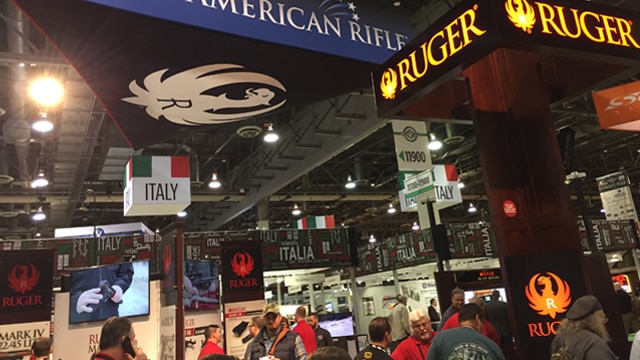
The Ruger booth at SHOT Show 2017 in Las Vegas was a hive of activity. (Photo: Daniel Terrill/Guns.com)
After showing surprisingly strong results for first quarter earnings, Sturm, Ruger & Company’s executive management reassured shareholders their company has shown growth even amid weak demand.
Ruger’s chief executive officer, Christopher Killoy, told shareholders at Tuesday’s meeting that while gun sales can be volatile, they also have very predictable patterns. “The seasonality of our industry is very well defined, very well predicted and pretty much understood by those of us in the business,” he said.
Killoy devoted a quarter of his hour-long presentation to market conditions and consumer trends. Pointing to a graph showing annual gun sales as far back as 1991, Killoy explained sales maybe going up and down, but there’s been an upward slope overtime.
He compared the spike in sales before last year’s election to the build up to the federal Assault Weapons Ban in 1994, which was followed by a sharp drop in sales. Putting it in context, Killoy explained the measure also coincided with an increase in licensing fees and regulations for federal firearms licensees.
“The message there is we’ve seen ups and downs before. This is not the first time the firearms industry has gone through change, be it up, be it down. We’ve seen this before. Over time we’ll likely see it again,” he said.
Killoy explained “the good news” is that the number of FFLs has been increasing over the past 10 years, many of which are smaller manufacturers rather than retailers. While that may suggest more competition, it means they likely won’t survive periods of weak demand.
While gun sales surged during last year’s first quarter amid calls for stricter gun control laws, the gun maker reported comparable results this year, even though expectations had been lowered and threats of more regulation wanes.
“Frankly, from a percentage standpoint, people have talked about the change in the firearms market since the November election, I think it would fair in saying the demise of the firearms industry was likely greatly exaggerated,” he said.
Ruger’s sales totaled $167.4 million from January through March, down from $173.1 million last year. National sales dropped 11.6 percent, according to federal data. The sell-through rate for Ruger products decreased by 7 percent in that same time frame. Firearms accounted for $166.4 million of quarter sales, down 3 percent.
“That first quarter, however, was not without it’s struggles. It was a very promotionally charged environment,” Killoy said.
Investors reacted to the strong results, but also Ruger fought for those strong results by buying back 1.4 million shares of stock and closely monitored distributor inventory levels. In anticipation of different election results, the company and others in the gun industry overproduced, which caused a clog at the distributor and retailer levels.
“The firearms industry … has its ups and downs, so this is a volatile industry. We’ve got a consistent game plan in good times and in bad,” he said.
The post Ruger has ‘consistent game plan’ in good times and bad appeared first on Guns.com.
